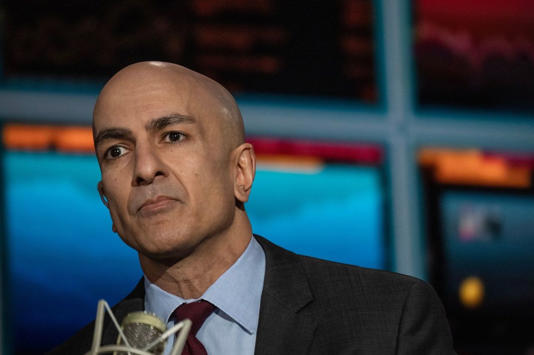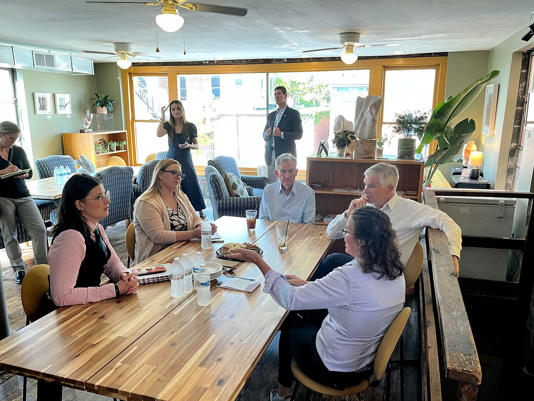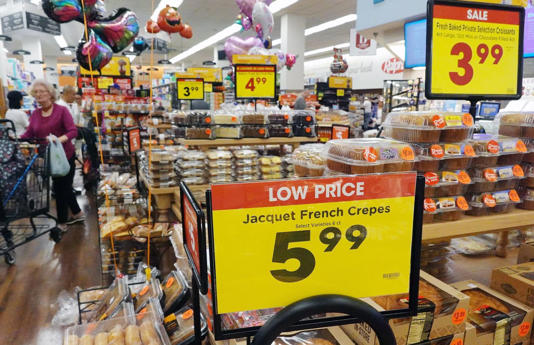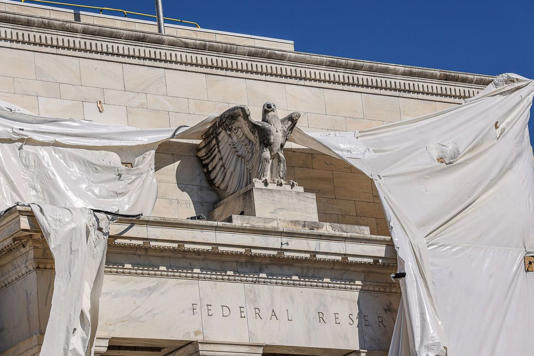
When Federal Reserve Chair Jerome Powell met on an October afternoon with small-business owners in Pennsylvania, Julie Keene lamented how her family farm and food market had been blindsided by high inflation over the past two years.
“Predictability is just gone,” said Keene, co-owner of Flinchbaugh’s Orchard & Farm Market in Hellam, Pa. “It is very hard to operate a business in a world where there is not predictability.”
Powell curtly told Keene he saw one clear solution: “We get inflation down.”
So far, so good. Inflation has fallen faster this year than many Fed officials anticipated after a hair-raising series of rate increases that none of them envisioned two years ago.
The big questions now are about when the Fed can start cutting rates and by how much. The answers will matter greatly to households, markets and possibly the 2024 presidential election.
One danger is that Powell and his colleagues—blamed for reacting too slowly to address surging inflation two years ago—will wait too long to lower rates as they ensure inflation is fully extinguished. That mistake could curb economic growth too much, causing a recession.
The Fed’s other big error would be to trim rates too soon, failing to vanquish inflation. The central bank doesn’t want to repeat its 1967 mistake, when it cut rates to bolster faltering growth only to see prices take off. Officials are wary of reducing rates prematurely for fear that new shocks—a run-up in oil prices, for example—ignite a new inflationary surge, as occurred throughout the 1970s.
Powell and his colleagues are on track to hold rates steady at their meeting this week. Officials last raised the benchmark federal-funds rate in July to a range between 5.25% and 5.5%, a 22-year high. The rate influences borrowing costs—such as rates on mortgages, credit cards and business loans—throughout the economy.
Fed officials aren’t likely to entertain serious conversations about when to cut rates this week—and potentially for several months unless the economy weakens more than expected.
Still, they don’t think rates need to remain at their current, economically restrictive setting indefinitely. Officials’ updated rate projections, to be released Wednesday after their meeting, will show that most expect to cut rates somewhat next year.
“It would be very difficult if they cut rates now only to turn around and hike again later,” said David Wilcox, a former senior Fed economist who is now at the Peterson Institute for International Economics. “At the same time, they need to be on their front foot, ready to ease as evidence accumulates that…inflation is persuasively moving down.”
Dueling hazards
Fed officials are trying to balance two risks: One is that they move too slowly to ease policy and the economy finally crumples under the weight of higher interest rates, causing millions of people to lose their jobs.
The other is that they ease prematurely and inflation settles above 3%, a level inconsistent with their 2% goal, which is aimed at providing the kind of predictability that Keene said her business needs.
Flinchbaugh’s, which sells produce and baked goods and operates an apple-processing plant, has been forced to raise prices or accept thinner margins as the costs of fuel, fertilizer and labor soared over the past year. While Keene supports the Fed’s rate increases to lower inflation, she said she hadn’t considered whether they might cause a recession.
“From the production side, yes, we need to get back to a predictable environment,” said Keene. But for her retail business, the idea of a recession “screams ‘freak out’ to me.”
The current business cycle is unlike any the Fed has faced in a half-century, so Powell has no historical playbook to guide his coming decisions. In most rate-hiking episodes in the past 35 years, the Fed sought to prevent inflation from rising rather than to lower it.
The outlook for the U.S. economy has brightened in recent months because inflation and wage growth are slowing. Core inflation, which excludes volatile food and energy prices, was 2.5% at an annualized rate over the six months through October, down from 4.5% over the previous six-month period, according to the Commerce Department.
Lower price pressures have diminished Fed concerns that consumers and businesses will come to expect inflation to stay high, causing it to do so. And slower wage growth has eased fears of a so-called wage-price spiral, in which higher inflation is sustained because paychecks and prices rise in lockstep.
“By aggressively getting rates up above inflation and continuing to hike until inflation rolled over, the Fed overtightened policy to ensure against a wage-price spiral,” said Tim Duy, chief economist at SGH Macro Advisors. “For all intents and purposes, the Fed has restored price stability.”
This opens up a path to lower rates to avoid a recession that might otherwise result from the lagged effects of the Fed’s past increases.
Two rate-cutting scenarios
Declining inflation could allow the Fed to consider whether and when to cut rates under two scenarios.
First, the Fed would cut simply because the economy is slowing and unemployment is rising faster than expected. If the unemployment rate starts to rise in a way consistent with past recessions, “we’re back to our normal playbook,” Chicago Fed President Austan Goolsbee said in an interview last month.
A second, more tantalizing prospect for investors is that the Fed would cut even though the economy is doing fine because monthly inflation readings have returned closer to the low levels seen before the pandemic. Holding rates steady as inflation falls would lead inflation-adjusted, or “real,” rates to rise, which the Fed doesn’t want. So officials could cut nominal rates to maintain real rates at a steady level.
Fed governor Christopher Waller fueled optimism about that possibility when he said recently that the central bank could theoretically begin reducing rates by the spring if inflation behaves especially well.
“If we see this [lower] inflation continuing for several more months—I don’t know how long that might be, three months, four months, five months?—we might feel confident that inflation is really down,” said Waller, whose comment drew special attention from investors because he has been a leading advocate for tighter policy since 2021.
The case for cuts under that scenario “has nothing to do with trying to save the economy or recession,” he said.
Officials have been reluctant to entertain public conversations around cutting rates for fear that Wall Street will race ahead and assume more reductions than could be warranted. That reaction could itself reduce borrowing costs, making it harder for the Fed to keep economic growth slow enough to finish the inflation fight.
“There are plenty of things that could cause them to say, ‘We’re not in a rush to do this,’” said Eric Rosengren, a former president of the Boston Fed. He thinks a rate cut as soon as the second quarter of 2024 is possible if inflation continues sliding on its current path.
How difficult is the last mile?
Most of the disagreements over when the Fed should cut stem from differences over whether inflation will continue declining.
One camp says that getting inflation down from a high of 7.1% last year to 3% in October is going to prove much easier than lowering it from 3% to the Fed’s 2% target. That is because most of the drop so far has reflected the unwinding of pandemic-related bottlenecks and worker shortages.
The fear is that this “last mile” of inflation reduction will require creating more slack in the economy—such as unemployed workers or idled factories. “I can’t see declaring ‘mission accomplished’ until you see some more labor market slack,” said Raghuram Rajan, a former governor of India’s central bank.
Such a strategy almost invites the Fed to keep policy too tight for too long. “Given that monetary policy operates with lag, it does set us up to likely overtighten. I don’t see how to avoid that,” Minneapolis Fed President Neel Kashkari said in an interview last month.
Another camp doesn’t assume the last mile will be particularly difficult. “There’s no evidence that we’ve stalled at 3%” inflation, Goolsbee said earlier this month.
One reason for optimism is that higher housing costs have been a driver of inflation over the past two years, but rent growth has slowed sharply over the past year. Because of the way government agencies calculate shelter costs, those declines filter through to official inflation gauges more gradually.
A model built by Wilcox, who is also a senior economist at Bloomberg Economics, indicates that the cool-down in rents could lower core inflation to 2.1% by the end of next year. The math “encourages me to think that the U.S. is much closer to conquering excess inflation than is commonly appreciated,” he said.
Since last year, Powell has been laser-focused on ensuring that he doesn’t repeat the mistakes of Arthur Burns, the Fed chairman in the 1970s who failed to beat rampant inflation—in part, because the central bank eased policy too soon to prevent higher joblessness. Paul Volcker later tamed soaring prices as chairman by ratcheting rates up so high they caused painful recessions in the early 1980s.
But as price pressures ebb, Powell faces the prospect of doing something that his predecessors couldn’t: lowering inflation without a big increase in joblessness.
It would be the central banking equivalent of what Capt. Chesley “Sully” Sullenberger achieved in 2009 by safely landing a commercial jet on a stretch of the Hudson River in New York City after losing engine power.
“It is very hard because the more he wants to be a ‘Sully,’ the more the markets know that he might blink,” said Rajan. “The compromise is staying put, watching what happens and being ready to raise rates if this doesn’t play out as everyone thinks.”
Write to Nick Timiraos at Nick.Timiraos@wsj.com
Source: The Wall Street Journal




